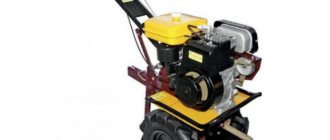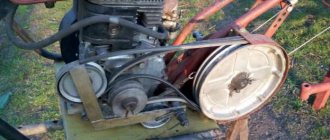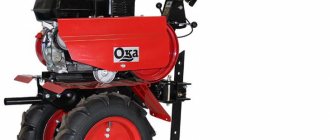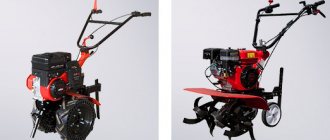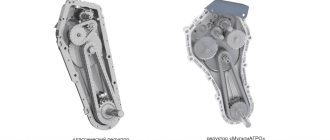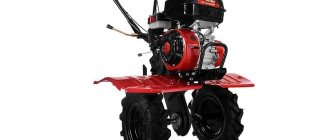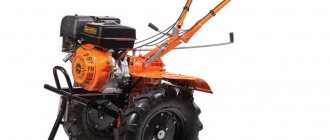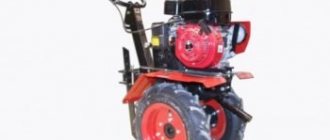Small-scale mechanization tools are gradually entering the agricultural industry, replacing the usual manual labor. This is a very positive trend, especially for older people who, for obvious reasons, can no longer fully work in their gardens.
In such cases, walk-behind tractors become indispensable assistants, thanks to which it is possible to carry out almost a complete range of work in agriculture.
The extreme simplicity of the design and intuitive controls allow them to be used even by people who are not particularly familiar with the technical side of the issue.
Of course, there are more complex models, but they are also intended mainly for professional farms and agro-industrial complexes.
For an ordinary person, a standard walk-behind tractor, without any frills, is quite suitable. One of these models is the KaDvi Oka MB 1D1M10 walk-behind tractor, specialized for work in rural areas.
Its simplicity should not mislead anyone - this is a full-fledged small-scale mechanization unit designed to work “on the ground”.
Description
The Oka MB-1D1M10 walk-behind tractor is a universal agricultural equipment designed to perform a wide range of agricultural work on land plots. Using the "Oka" MB-1D1M10, you can carry out mechanized cleaning of lawns, vegetable gardens, garden paths, and household plots. This model can be used all year round, even in harsh weather conditions (down to -50C).
Motoblock-OKA-MB-1D1M10
MB-1D1M10 is from Kaluga (Russia). The walk-behind tractor of this model is equipped with a Lifan 168F-2A engine with a power of 6.5 hp.
What engine can be installed on the Neva walk-behind tractor?
The design features of the supporting structures of the Neva model range make it possible to install and adapt for operation power units produced by various foreign brands. This expands the capabilities of walk-behind tractors and makes them suitable for operation in the most difficult weather conditions. Below we will consider the brands of engines that can be installed on Neva walk-behind tractors.
Lifan
Lifan brand motors have proven themselves to be durable power units with a tight fit of built-in factory components and a relatively low level of vibration and noise generated. Other features of power units of this brand include reduced fuel consumption and stable operation in almost any weather conditions.
Most often, 4-stroke gasoline engines Lifan 177 F are installed on Neva brand walk-behind tractors. The crankshaft of these internal combustion engines is located in a horizontal position. The design of these engines includes 1 chrome-plated working cylinder with a volume of 270 cm3. The power of the power unit is 9 liters. With. This is enough for high-quality plowing of dense clay soils and cultivation of small areas with virgin soils.
The Lifan 177 F engine is distinguished by the simplicity of its factory design. The minimum number of built-in parts makes maintenance and repair of this motor as quick and easy as possible.
Subaru
In some cases, Subaru brand engines are included in the factory equipment of Neva walk-behind tractors. If the agricultural unit was purchased with a different engine, then it can be replaced with a Japanese power unit with your own hands.
Most often, Robin-Subaru EX 17 4-stroke 1-cylinder gasoline engines are used for installation on Neva walk-behind tractors. They are distinguished by their average power values - this parameter is 6 hp. With. These engines are started using a built-in manual starter, and heated parts are cooled using an air cooling system.
The valves in the Robin-Subaru EX 17 engine are located in its upper part. The stock crankshaft is in a horizontal position, which reduces the vibration created by the engine. Other powertrain parameters include:
- crankshaft rotation speed – 4000 rpm;
- working cylinder capacity – 169 cm3;
- fuel tank capacity - 3.6 l;
- oil sump capacity – 0.6 l;
- compression index – 8.5;
- the maximum permissible torque is 8.1 Nm.
The Robin-Subaru EX 17 engine is equipped with an improved lubrication system, which operates on the principle of oil splashing. This allows you to save lubricating fluid even when the engine is operating under the highest possible loads.
Patriot
Among the main design features of Patriot brand engines, it is necessary to highlight the built-in durable filter with 3-level purification of the intake air. The filter is designed in such a way that even if 70% of the area is heavily clogged, it regularly performs its tasks, ensuring a stable supply of clean air to the carburetor.
In most cases, replacing the engine on a Neva walk-behind tractor is done using a 4-stroke, 1-cylinder gasoline engine, the Patriot SR 210. It is distinguished by its modest physical dimensions and light weight. At the same time, its maximum power is 7 liters. With. sufficient for quick and high-quality plowing of small and medium-sized areas with hard clay soils.
The motor in this configuration is equipped with a durable shaft, the diameter of which is 19.05 mm. The maximum permissible torque of the power unit is 14 Nm, and the engine fuel consumption is 360 g/kW/h.
The ignition of the Patriot SR 210 engine is transistor-magnetic. It works reliably even when starting the engine in the most difficult weather conditions.
Honda
In the event of a breakdown of the standard power unit, Honda GX 160 and GX 200 engines can be installed on Neva walk-behind tractors. Among the main advantages of the Japanese brand’s internal combustion engine is a simplified design with the most tightly fitted components and factory mechanisms. Thanks to the small number of parts, even a novice user can repair Honda engines.
The GX series from the Japanese brand is one of the most popular lines of engines for agricultural machinery.
Among the advantages of these motors it is necessary to highlight:
- easier start-up, which was achieved thanks to the built-in decompression system;
- compliance with the highest environmental safety standards;
- reduced fuel and lubricant consumption;
- More efficient fuel combustion thanks to proprietary OHV design.
The GX 160 and GX 200 engines stand out with average power ratings of 5.5 and 6.5 liters. With. respectively. This does not prevent them from successfully solving the tasks assigned to them even when working under the highest loads.
Specifications
| Parameter | Parameter value |
| Gearbox type | Chain |
| Overall dimensions, mm., no more | 1500x600x1050 |
| Operating weight, kg., no more | 90 |
| Ground clearance, mm. | 140 |
| Transport gauge, adjustable, mm. | 310, 590 |
| Traction force, kgf., not less | 100 |
| Travel speed | 1st gear - 3.6 km/h 2nd gear - 9 km/h |
Modifications
Available modifications of the Oka MB-1D1M10 Motoblock:
- 1D1M1 (with domestic KADVI DM-1M1 engine);
- 1D1M6 (with Japanese Mitsubishi, 6 hp);
- 1D1M7 (engine made in the USA, Briggs&Stratton, 6 hp);
- 1D1M13 (USA, Robin Subaru EX 17 PREMIUM, 6 hp);
- 1D1M14 (also USA, Robin Subaru EX 21 PREMIUM, 7 hp);
- 1D1M15 (domestic KADVI 168F - 2A, 6.5 hp)
KADVI DM-1M1 engine Mitsubishi engine, 6 hp Briggs&Stratton engine, 6 hp Robin Subaru EX 17 PREMIUM engine, 6 hp Robin Subaru EX 21 engine KADVI 168F-2A engine
Engine
As previously mentioned, Luch MB 1 can be equipped with various power plants. Thus, the range is represented by engines of famous brands. For example, among foreign models, let's pay attention to Subaru, Lian-Long, as well as the more affordable Vanguard and Lifan. And yet, the most common modification is considered to be the Luch MB 1 with the domestic KADVI 168F-2A engine, which uses foreign components from Honda. This power plant is the pride of Russian and Japanese engineers. The engine has an overhead cylinder arrangement and has fairly high acceleration capabilities, and at the same time the unit is very economical in terms of fuel consumption. Among the main advantages of the motor are its attractive design, light weight, powerful performance and minimal noise level.
The Russian-Japanese engine has a single-cylinder four-stroke design and, with a displacement of 0.3 liters, develops 3.7 horsepower. The cylinder diameter is 76 mm. The power plant supports fuel grades A-76, as well as A-80 and A-92.
The manufacturer draws attention to the safety rules that must be followed when operating a walk-behind tractor with this motor. In particular, owners of KADVI 168F-2A engines are prohibited from adding fuel while the engine is running. Also, do not touch the ignition wire and spark plug bracket.
Advantages of the model
The main advantages of the Oka MB-1D1M10 are:
- adjustable steering wheel (allows operators of any height to operate the equipment);
- smooth running due to the chain gearbox (V-belt drive);
- ergonomic design, thanks to which the walk-behind tractor confidently and easily passes even the most difficult soils;
- protective wings for cutters - all Oka mechanisms are kept clean;
- the performance of MB-1D1M10 is increased due to connecting rod bearings;
- economical fuel consumption along with high operating power;
- the sound pressure of the Oka of this model is reduced by 30% - the result of the box-shaped muffler;
- built-in decompressor;
- the presence of reverse, providing reverse movement of the unit;
- cylinder with cast iron sleeve;
- large load capacity due to the considerable weight of the machine (up to 500 kg with the weight of the equipment itself being 90 kg).
In fact, the Oka MB-1D1M10 walk-behind tractor is practically a “minitractor”, because with its help you can perform a wide range of household work that is inaccessible to equipment of less power and maneuverability: snow removal, grass mowing, watering, digging up root crops, hilling soils of any density, crushing feed for livestock, cleaning the area with brushes and a shovel-mouldboard, plowing even the densest soils.
Even an operator without experience can operate this device; the main thing is to set the direction of movement and not try to drive the walk-behind tractor yourself, using excessive force.
The standard package of MB-1D1M10 includes:
- 4 cutters;
- transport wheels;
- axle extensions.
Reviews about the main features of the walk-behind tractor
The above-mentioned walk-behind tractor has been produced since 1984. During this time, the technology managed to win the trust of many consumers. Over time, the unit has been improved and modernized, but you can still find working copies from the 90s. The manufacturer is in the city of St. Petersburg. The company specializes in the production of motorcycle and agricultural machinery.
Consumers emphasize that the MB-1 walk-behind tractor is constantly being modernized and is popular among buyers, as it has been time-tested. Over time, this equipment was equipped with a new gearbox with an increased number of gears, which is very popular with land owners. The technique provides three variable gears and one reverse gear. If you change the belt to a double belt pulley, you can get another set of gears.
Instructions for using the device
Replacing consumables (oil, fuel) Engine oil changes in the MB-1D1M10 must be performed according to the manufacturer’s instructions: the first after start-up - after 5 hours, then - at intervals of 25 hours.
Recommended oil:
| Volume | Oil type | |
| Crankcase | 1,3 | Automotive motor oil for carburetor engines M-53/10G1 or M-63/12G1, or any oil that meets the requirements of API: SF, SG, SH and SAE: 10W-30, 15W-30 |
| Walk-behind tractor gearbox | 1,8 | Transmission oil TAD-17I, TAP-15V, etc. GOST 23652-79 or other, in accordance with SAE: 80...85W API: GL3...GL4. |
The transmission oil should be changed every 100 operating hours.
The factory instructions for the walk-behind tractor prescribe the use of oil TAD-17I, TAP-15V and others in accordance with GOST 23652-79; it is also allowed to combine oils in any proportion.
Recommended fuel: high-quality gasoline AI92.
Before starting work with the walk-behind tractor, make sure that all components are securely fastened. Do not shift from forward to reverse with the engine running! This may cause damage. To safely shift from forward to reverse, stop the engine, shift the shift lever to the desired position, and then start the engine again.
Daily Maintenance
- Remove dust, dirt, and oil from the external surfaces of the engine.
- Inspect the connection of the cylinder head to the engine cylinder block; if necessary, tighten the cylinder head bolts on a cooled engine in a diametrically opposite manner crosswise through 3 bolts.
- Check the reliability of the engine mounting and, if necessary, tighten loose connections.
- Check the tightness of the gas line hose connections from the fuel tank to the carburetor.
- Clean the protective casing (inlet to the fan) from foreign objects.
Technical inspection after 25 hours of operation: check the tightness of the gas hoses, add oil, and after 50, check the degree of tension of the V-belt drive belts, replace the transmission oil.
The Oka MB-1D1M10 walk-behind tractor is designed to operate at temperatures down to -50C. In winter, the following manipulations will help make starting easier: before work, the walk-behind tractor must be in a warm room for at least 10 hours. You can pour oil heated to 50-60 degrees into the engine. After adding hot oil, allow the engine parts to warm up for 10-15 minutes.
If the engine does not start, you should warm up the carburetor pipe and the carburetor itself by placing a cloth moistened with hot water on them.
Carburetor of MB-1 walk-behind tractor
Let's look at the carburetor of the MB-1 walk-behind tractor. The device regulates the fuel supply to the engine and prepares the combustible mixture (mixing fuel with air). It is part of an internal combustion engine.
Why do you need to adjust the carburetor? A situation may arise when the walk-behind tractor begins to work unstably. This can happen if the unit has not been used for a long time or, on the contrary, has undergone heavy loads. In such a situation, you will need to adjust the carburetor, for which there are special instructions.
The carburetor must be adjusted in the following sequence:
- Tighten the full and low throttle screws all the way (without overdoing it), and then unscrew them one and a half turns.
- Start the engine and wait 10 minutes for it to warm up.
- Without turning off the engine, set the lever to minimum speed.
- Using the screw (throttle valve), which regulates the amount of fuel flowing, you need to achieve such a minimum idle speed at which the interruptions will stop.
- Adjust the throttle screw to maximum and then to minimum. This must be done until the motor starts working normally.
- Move the engine lever to gas.
- Set the throttle screw to a maximum of 2.5 turns.
The MB-1 walk-behind tractor has the following attachments:
- Plow. Designed for plowing land.
- Hiller. For trimming furrows.
- Root digger.
Attachments for Oka MB-1D1M10
From the manufacturer
The Oka manufacturer recommends using attachments manufactured by Kaluga Engine OJSC for aggregation with a walk-behind tractor.
The offered range of equipment includes the following additional devices:
Harrow Cultivator FR.40.000 Root digger Hiller Grousers Standard plow PM-1 Hitch SUM-1 Weights Shovel-dump Rotary snow blower Potato planter Cargo cart
From third parties
Attachments from other manufacturers can also be used in combination with the Oka MB-1D1M10 walk-behind tractor, if the dimensions of the fastening units correspond to those produced by CADVI.
Reworking products from other manufacturers with unsuitable fasteners is unacceptable!
Other manufacturers whose attachments can be used with Oka:
- MOBIL K LLC, Gagarin;
- CJSC "Vsevolozhsk RMZ";
- PC "Rusich".
It is also possible to make additional components for the walk-behind tractor yourself, after which they can be used. However, the cost of homemade attachments, based on the necessary consumables, will be almost equal to the factory ones.
Owner reviews
Victor, Penza:
“I have an Oka DM-1 with a 6 hp engine. — so its main drawback is great noise. Therefore, the engine mainly performs its functions at medium speeds. I’ve been using it for 5 years, there are no comments, I don’t even consider replacing the belt and spark plugs, these are consumables. My opinion: the most important thing is to change the engine oil once a season and clean the air filter. This walk-behind tractor does not need any modifications. I almost always use my eye in first gear, mainly for digging up potatoes, and sometimes I also use the plow. I mill and use the unit with a trolley at second speed. Two speeds are enough for me, especially since the engine is powerful. The main disadvantages, in my opinion, are: it’s difficult to check the transmission oil level, and it’s difficult to change, you need to roll the plug on its side. The handle beam is well adjustable. In general, I give this technique a big thumbs up.”
Nikolay, Rostov-on-Don:
“As the owner of this mini-tractor, I like the fact that ball bearings have been installed on the Oka for a long time, and if there is enough lubricant, the chains will generally last forever. In my village, all my neighbors have about 20 walk-behind tractors, and all of them are Oka. There were never any problems with spare parts, and the chains never broke like in Chinese walk-behind tractors. They say that sometimes there can be a problem with shifting gears, but I haven’t had any of these. Technique fire!

